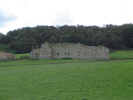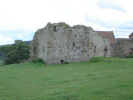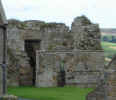

 Danby Castle was built to replace an earlier castle at Castleton. It is a quadrangular castle - essentially a rectangular building with a central courtyard and towers at each corner. This type of castle was quite common in the north of England at the end of the fourteenth century, and Danby Castle is normally dated to that period, or to the early years of the fifteenth century.
Danby Castle was built to replace an earlier castle at Castleton. It is a quadrangular castle - essentially a rectangular building with a central courtyard and towers at each corner. This type of castle was quite common in the north of England at the end of the fourteenth century, and Danby Castle is normally dated to that period, or to the early years of the fifteenth century.
 This fits well with a change of ownership at Castleton. For most of the fourteenth century it was owned by the Latimer family. However, in 1381 the last Latimer died without a male child. He did have a daughter, Elizabeth, who had married John Neville of Raby. They inherited the castle in 1381. Neville died seven years later, leaving Elizabeth in control of the estates until her death in 1396. The estate was then inherited by her son, another John. In 1396 he was only seventeen, so had to wait until he came of age in 1400 to gain control of his estates. John Neville was not his fathers oldest son - that honour went to Ralph Neville, some thirty years old than John, and Earl of Westmorland since 1397. To mark the establishment of his own family, John soon took the title of Lord Latimer. He was probably the builder of Danby Castle, although it is also possible that his father built it to provide a home for his new child, or that Elizabeth built it after the death of her husband, to provide herself with a more comfortable home than that provided by the older building at Castleton.
This fits well with a change of ownership at Castleton. For most of the fourteenth century it was owned by the Latimer family. However, in 1381 the last Latimer died without a male child. He did have a daughter, Elizabeth, who had married John Neville of Raby. They inherited the castle in 1381. Neville died seven years later, leaving Elizabeth in control of the estates until her death in 1396. The estate was then inherited by her son, another John. In 1396 he was only seventeen, so had to wait until he came of age in 1400 to gain control of his estates. John Neville was not his fathers oldest son - that honour went to Ralph Neville, some thirty years old than John, and Earl of Westmorland since 1397. To mark the establishment of his own family, John soon took the title of Lord Latimer. He was probably the builder of Danby Castle, although it is also possible that his father built it to provide a home for his new child, or that Elizabeth built it after the death of her husband, to provide herself with a more comfortable home than that provided by the older building at Castleton.
The most famous inhabitant of Danby Castle was Catherine Parr, Henry VIII's final wife, who survived him by one year. John Neville, third Baron Latimer (1493-1543) was her second husband. They married in 1534, two years before the Pilgrimage of Grace, a rebellion against Henry triggered by his attacks on the Catholic church. This rebellion caused Catherine and her family great problems. Late in 1536 the rebels seized John Neville at his main home of Snape Castle (south of Bedale) and forced him to join them (although Snape was their main residence, Dandy was an important estate centre, and would still have been used by the family). He was not an enthusiastic rebel. The rebels were soon convinced that he was about to betray them to the king, and returned to Snape, where they took Catherine and Neville's two children by an earlier marriage hostage. Neville was able to use his influence with the rebels to get his family released, but by  now Henry was convinced that he was a traitor. Ironically, it was Catherine's family's influence with the king that saved Neville, just as his influence with the rebels had saved Catherine! Unsurprisingly, after this experience the family moved south, and Catherine rarely returned to the north. Neville died on 2 March 1543. Four months later, on 12 July, Catherine married Henry VIII.
now Henry was convinced that he was a traitor. Ironically, it was Catherine's family's influence with the king that saved Neville, just as his influence with the rebels had saved Catherine! Unsurprisingly, after this experience the family moved south, and Catherine rarely returned to the north. Neville died on 2 March 1543. Four months later, on 12 July, Catherine married Henry VIII.
Although the castle is ruined, quite a bit of it still survives. Three of the four towers still exist in some form - the two northern towers as ruins, the south-eastern as part of the modern farmhouse. The south wing also survives intact and contains the Court and Jury rooms for the Court Leet. This is a rare example of a manor court still in operation. Every October the court meets to administer the common rights on the Danby Estate.
Grid Reference: NZ 717 073
Danby Castle is in private hands, and is a working farm. See their web site for further details.